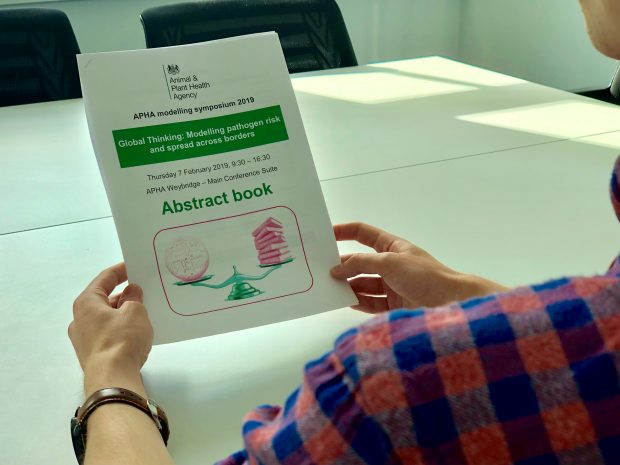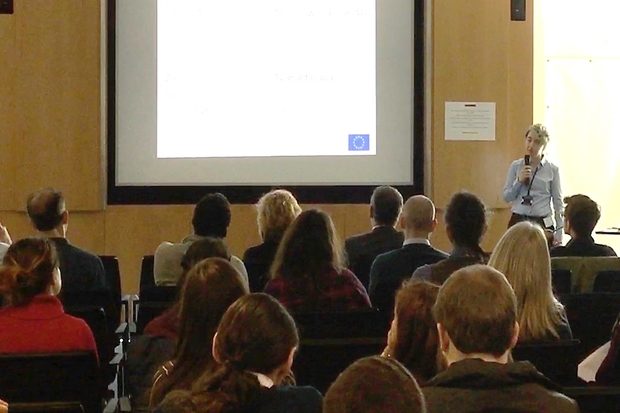Verity Horigan, Risk Analyst at APHA talks about the 9th annual modelling symposium held at APHA Weybridge in February.

Not being a mathematical modeller myself, I find just the mention of the word ‘model’ a bit daunting and my mind starts to wobble, in the same way as it does when faced with ‘Terms and Conditions’ or ‘Insurance Policies’. However, one of the main aims of the APHA modelling symposium is to integrate knowledge between modellers and policy makers, and the talks therefore tend to be presented in more familiar words. As one modelling colleague pointed out to me “who better than you to curb the natural impulse of modellers to fill their presentations with equations?”
This year’s symposium was on ‘Global thinking: Modelling pathogen risk and spread across borders’. Sounds a bit daunting maybe, but the upshot of it is that pathogens don’t respect man-made borders so methods are needed to predict where, and how, pathogens are going to spread from country to country in the future. This is vitally important for national disease surveillance and management policies.
Historically, individual countries have tended to work independently, and multiple models and frameworks have often been developed for the same pathogen. One way of utilising these multiple models is to combine all of their outputs into one prediction. Dr Tom Lindström (Linköping University) presented this idea otherwise known as ensemble modelling. The premise being that it’s often difficult to describe all aspects of disease processes within one model so combining several models can indicate to policy makers the amount of uncertainty in the outputs.
Results using several models applied to the 2001 United Kingdom (UK) Foot and Mouth Disease outbreak suggested that ensemble modelling could be a powerful tool for planning for disease outbreaks by selecting the best policy response to limit the spread and consequences of the disease.
More recently, European collaborations have developed the concept of generic models which aim to contain all possible pathways of disease introduction in one framework, are applicable to multiple diseases and work for different spatial scales. Our Epidemiological Sciences department has been involved in several European projects developing such models.
APHA’s Dr Rachel Taylor gave an overview of her work on the COMPARE project, showcasing how the generic framework was applied to the case study of Lumpy Skin Disease and has just been applied to African swine fever (ASF), a pathogen which has threatened pig production in Eastern Europe of late and has recently entered Western Europe.

The concept of generic models has also been applied to plant pathogens. Prof. Stephen Parnell (University of Salford) illustrated how such models are commonly used to map the risk of plant pest invaders in new areas. Personally, I found this talk really interesting - an ecological horror story describing the potential threat of the bacterium Xylella fastidiosa to the European Union. Being a promiscuous pathogen, the number of plant species it can infect is seriously worrying and the pictures of ancient olive trees in Italy which have already been affected was a stark image of the destruction it can cause. The bacterium can survive in a wide range of climatic zones, including the UK and it is already known to have affected trees such as oaks and elms in North America.
One of the drawbacks with generic models is that large amounts of data are required and the quality of the data can be an issue. The adage of ‘models are only as good as the data they use’ or ‘garbage in/garbage out’, was emphasised by Dr Robin Simons (APHA) and Dr Willie Wint (University of Oxford) who both gave presentations about the benefits and drawbacks of using global datasets in models.
One of the most important challenges is the issue of missing data e.g. are absent data a true negative or simply not reported? Having been involved in the work presented by Robin, I am very familiar with the frustration of finding a large dataset and then realising it is missing several key data points; it is a bit like using premium quality baking equipment but then adding salt instead of sugar and forgetting the eggs completely – it may still look like a cake and technically be edible, but it tastes of disappointment.
Keynote speaker, Dr Guillaume Fournié (Royal Veterinary College) reiterated the concern of the dependence on reliable data particularly in low and middle income countries, where absence of relevant data or difficulty in assessing their quality and limitations may occur. Social science can be of benefit in these situations providing knowledge of how human behaviour, influenced by social and economic factors, can influence disease transmission.
So, how good are these generic models? Dr Clazien de Vos (Wageningen University & Research) presented an investigation into the outcome of multiple different generic models to assess the incursion of ASF. The models, including Dr Taylor’s COMPARE model, were all using the same global datasets for disease occurrence and trade in live animals and animal products. Whilst the tools expressed their outputs in various ways they generally agreed on the risks.
All speakers stressed the need for optimised data collection to improve the applicability of generic models to different scenarios. As more and more data becomes available it’s likely that generic models will become more widely used although, as yet, I’m not sure they incorporate a ‘chaos’ factor to explain how sporadic events such as the appearance of Bluetongue in Western Europe in 2006 occurred.

A common theme of the modelling symposiums over the years has been data gathering and sharing. The key point from this year’s symposium, as emphasised in the introduction speech given by the UK Chief Veterinary Officer, Christine Middlemiss, was about how communication is implicit to effective data sharing. Dr Wint emphasised the advantage of sharing data between groups and the importance of modelling outputs being presented in such a way that is easy to understand and has maximum impact to inform policy makers. Communication by way of an interdisciplinary approach, as illustrated by Dr Fournié’s presentation, was also a good reminder that pathogen spread is not just a biological process but is affected by influences from economic and social factors too.
Why not get in touch
The symposium stimulated lots of interesting debate and discussion points. Please feel free to leave comments in the box below if you were there and enjoyed the event, or if you have any questions on how modelling can contribute to research and society.
Enjoyed reading? Then why not subscribe to the APHA Science Blog

Recent Comments